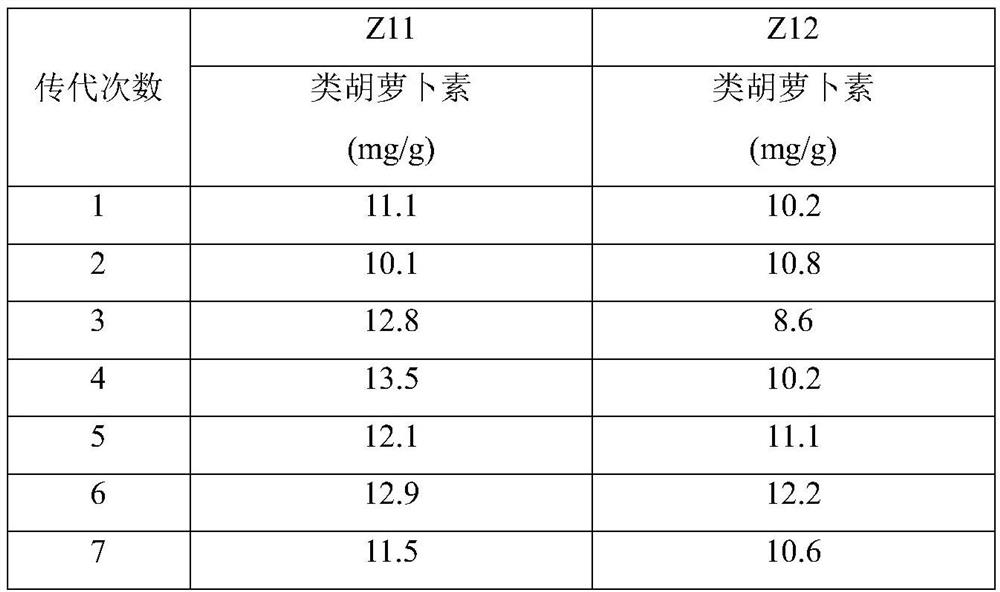Strain for co-producing unsaturated fatty acid and carotenoid and application thereof
A technology of unsaturated fatty acids and carotene, applied in the field of bacterial strains that co-produce unsaturated fatty acids and carotenoids, can solve the problems of chemical reagents remaining on the bacteria, discounts on the reuse value of bacteria residues, etc., and achieve great social significance and Economic value, strong tolerance effect
- Summary
- Abstract
- Description
- Claims
- Application Information
AI Technical Summary
Problems solved by technology
Method used
Image
Examples
Embodiment 1
[0027] Example 1: This example illustrates the screening method of Rhodosporidium toruloides.
[0028] The original strain of Rhodosporidium toruloides was a wild fungus screened from the soil collected from the lake near the Xiyuan cafeteria of Nanjing University of Technology;
[0029] Specifically, the YPD plate is used as the culture medium, cultured under aerobic conditions at 30°C, cultured for 2-4 days, streaked and purified 5-7 times, and finally the strains that can grow on the plate are verified, and their Fermentation, investigation of its fermentation products and performance, found that the strain can use a lot of carbon sources for growth, and can produce trace amounts of carotenoids. This strain was used as the starting strain for strain transformation.
[0030] The method for performing the first step of ion beam mutagenesis is as follows:
[0031] Use the original strain of Rhodosporidium toruloides for activation culture, culture temperature 30°C, 100mL sha...
Embodiment 2
[0048] Example 2: This example illustrates the passage stability of mutant strains Z11 and Z12.
[0049] The passage stability of mutant strains Z11 and Z12 was detected in the fermentation medium with glucose as carbon source. The subculture fermentation test results of strains Z11 and Z12 are shown in Table 2:
[0050] Table 2 strains Z11 and Z12 subculture fermentation test results
[0051]
[0052] It can be seen from the experimental results that after 7 consecutive passages, the carotenoid production of the two mutant strains is relatively stable, and they have good passage stability, which can be used as production strains for further research and development.
Embodiment 3
[0053] Example 3: This example illustrates the process of fermenting and producing carotenoids from Rhodosporidium toruloides Z11.
[0054] The culture medium formula described in the present embodiment (% is mass percent):
[0055] Plate medium: yeast powder 1%, peptone 2%, glucose 2%, agar 2%, the rest is water, pH 6.
[0056] Seed medium: 1% yeast powder, 2% peptone, 2% glucose, and the rest is water.
[0057] Fermentation medium: glucose 8%, K 2 HPO 4 0.04%, NaH 2 PO 4 0.1%, MgSO 4 ·H 2 O 0.15%, yeast extract 0.175%, the trace elements are: ZnSO 4 , CaCl 2 , MnCl 2 、CuSO 4 are 0.192×10 -7 g / L, 0.167g / L, 0.54×10 -4 g / L, 0.16×10 -4 g / L.
[0058] Rhodosporidium toruloides Z11 was inoculated on the plate medium for aerobic culture, the culture temperature was 30° C., and the culture time was 26 hours. Inoculate the Z11 cultured on the plate into the seed medium, the liquid volume in a 250mL Erlenmeyer flask is 50mL, the culture temperature is 30°C, and the cult...
PUM
 Login to View More
Login to View More Abstract
Description
Claims
Application Information
 Login to View More
Login to View More - R&D
- Intellectual Property
- Life Sciences
- Materials
- Tech Scout
- Unparalleled Data Quality
- Higher Quality Content
- 60% Fewer Hallucinations
Browse by: Latest US Patents, China's latest patents, Technical Efficacy Thesaurus, Application Domain, Technology Topic, Popular Technical Reports.
© 2025 PatSnap. All rights reserved.Legal|Privacy policy|Modern Slavery Act Transparency Statement|Sitemap|About US| Contact US: help@patsnap.com



